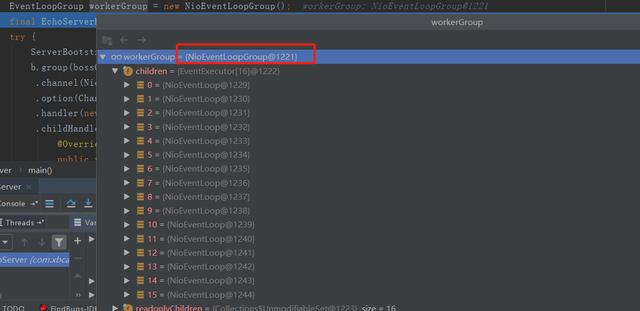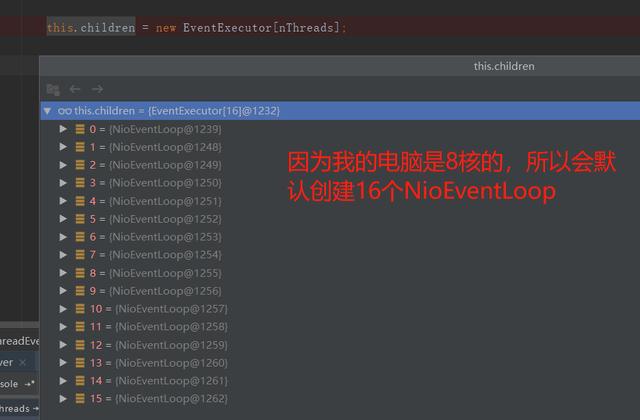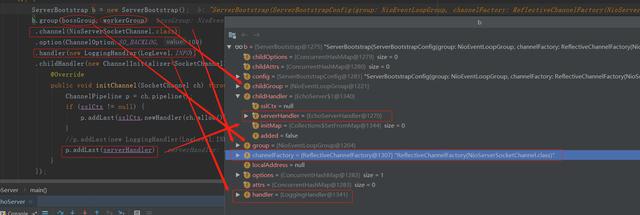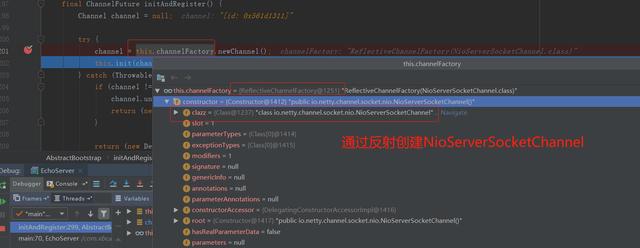基本说明
1、只有看过Netty源码,才能说是真正的掌握了Netty框架;
2、在io.netty.example包下,有很多netty源码案例,可以用来分析;
3、源码分析,是针对有Java项目经验,并且玩过框架源码的人员来讲的,否则会有相当的难度;
源码剖析目的
用源码分析的方式走一下Netty(服务器)的启动过程,更好地理解Netty的整体设计和运行机制;
1、源码需要剖析到Netty调用doBind方法,追踪到NioServerSocketChannel的doBind;
2、并且要Debug程序到NioEventLoop类的run代码,无限循环,在服务端运行。
@Overrideprotected void run() { int selectCnt = 0; for (;;) { try { int strategy; try { strategy = selectStrategy.calculateStrategy(selectNowSupplier, hasTasks()); switch (strategy) { case SelectStrategy.CONTINUE: continue; case SelectStrategy.BUSY_WAIT: // fall-through to SELECT since the busy-wait is not supported with NIO case SelectStrategy.SELECT: long curDeadlineNanos = nextScheduledTaskDeadlineNanos(); if (curDeadlineNanos == -1L) { curDeadlineNanos = NONE; // nothing on the calendar } nextWakeupNanos.set(curDeadlineNanos); try { if (!hasTasks()) { strategy = select(curDeadlineNanos); } } finally { // This update is just to help block unnecessary selector wakeups // so use of lazySet is ok (no race condition) nextWakeupNanos.lazySet(AWAKE); } // fall through default: } } catch (IOException e) { // If we receive an IOException here its because the Selector is messed up. Let's rebuild // the selector and retry. https://github.com/netty/netty/issues/8566 rebuildSelector0(); selectCnt = 0; handleLoopException(e); continue; } selectCnt++; cancelledKeys = 0; needsToSelectAgain = false; final int ioRatio = this.ioRatio; boolean ranTasks; if (ioRatio == 100) { try { if (strategy > 0) { processSelectedKeys(); } } finally { // Ensure we always run tasks. ranTasks = runAllTasks(); } } else if (strategy > 0) { final long ioStartTime = System.nanoTime(); try { processSelectedKeys(); } finally { // Ensure we always run tasks. final long ioTime = System.nanoTime() - ioStartTime; ranTasks = runAllTasks(ioTime * (100 - ioRatio) / ioRatio); } } else { ranTasks = runAllTasks(0); // This will run the minimum number of tasks } if (ranTasks || strategy > 0) { if (selectCnt > MIN_PREMATURE_SELECTOR_RETURNS && logger.isDebugEnabled()) { logger.debug("Selector.select() returned prematurely {} times in a row for Selector {}.", selectCnt - 1, selector); } selectCnt = 0; } else if (unexpectedSelectorWakeup(selectCnt)) { // Unexpected wakeup (unusual case) selectCnt = 0; } } catch (CancelledKeyException e) { // Harmless exception - log anyway if (logger.isDebugEnabled()) { logger.debug(CancelledKeyException.class.getSimpleName() + " raised by a Selector {} - JDK bug?", selector, e); } } catch (Error e) { throw (Error) e; } catch (Throwable t) { handleLoopException(t); } finally { // Always handle shutdown even if the loop processing threw an exception. try { if (isShuttingDown()) { closeAll(); if (confirmShutdown()) { return; } } } catch (Error e) { throw (Error) e; } catch (Throwable t) { handleLoopException(t); } } }}这里我们直接用官网提供的源码进行分析,这里先贴出官网的源码,然后再对源码进行分析,服务端代码EchoServer
public final class EchoServer { static final boolean SSL = System.getProperty("ssl") != null; static final int PORT = Integer.parseInt(System.getProperty("port", "8007")); public static void main(String[] args) throws Exception { // Configure SSL. final SslContext sslCtx; if (SSL) { SelfSignedCertificate ssc = new SelfSignedCertificate(); sslCtx = SslContextBuilder.forServer(ssc.certificate(), ssc.privateKey()).build(); } else { sslCtx = null; } // Configure the server. EventLoopGroup bossGroup = new NioEventLoopGroup(1); EventLoopGroup workerGroup = new NioEventLoopGroup(); final EchoServerHandler serverHandler = new EchoServerHandler(); try { ServerBootstrap b = new ServerBootstrap(); b.group(bossGroup, workerGroup) .channel(NioServerSocketChannel.class) .option(ChannelOption.SO_BACKLOG, 100) .handler(new LoggingHandler(LogLevel.INFO)) .childHandler(new ChannelInitializer() { @Override public void initChannel(SocketChannel ch) throws Exception { ChannelPipeline p = ch.pipeline(); if (sslCtx != null) { p.addLast(sslCtx.newHandler(ch.alloc())); } //p.addLast(new LoggingHandler(LogLevel.INFO)); p.addLast(serverHandler); } }); // Start the server. ChannelFuture f = b.bind(PORT).sync(); // Wait until the server socket is closed. f.channel().closeFuture().sync(); } finally { // Shut down all event loops to terminate all threads. bossGroup.shutdownGracefully(); workerGroup.shutdownGracefully(); } }}服务端业务端逻辑代码EchoServerHandler
/** * Handler implementation for the echo server. */@Sharablepublic class EchoServerHandler extends ChannelInboundHandlerAdapter { @Override public void channelRead(ChannelHandlerContext ctx, Object msg) { ctx.write(msg); } @Override public void channelReadComplete(ChannelHandlerContext ctx) { ctx.flush(); } @Override public void exceptionCaught(ChannelHandlerContext ctx, Throwable cause) { // Close the connection when an exception is raised. cause.printStackTrace(); ctx.close(); }}客户端代码EchoClient
/** * Sends one message when a connection is open and echoes back any received * data to the server. Simply put, the echo client initiates the ping-pong * traffic between the echo client and server by sending the first message to * the server. */public final class EchoClient { static final boolean SSL = System.getProperty("ssl") != null; static final String HOST = System.getProperty("host", "127.0.0.1"); static final int PORT = Integer.parseInt(System.getProperty("port", "8007")); static final int SIZE = Integer.parseInt(System.getProperty("size", "256")); public static void main(String[] args) throws Exception { // Configure SSL.git final SslContext sslCtx; if (SSL) { sslCtx = SslContextBuilder.forClient() .trustManager(InsecureTrustManagerFactory.INSTANCE).build(); } else { sslCtx = null; } // Configure the client. EventLoopGroup group = new NioEventLoopGroup(); try { Bootstrap b = new Bootstrap(); b.group(group) .channel(NioSocketChannel.class) .option(ChannelOption.TCP_NODELAY, true) .handler(new ChannelInitializer() { @Override public void initChannel(SocketChannel ch) throws Exception { ChannelPipeline p = ch.pipeline(); if (sslCtx != null) { p.addLast(sslCtx.newHandler(ch.alloc(), HOST, PORT)); } //p.addLast(new LoggingHandler(LogLevel.INFO)); p.addLast(new EchoClientHandler()); } }); // Start the client. ChannelFuture f = b.connect(HOST, PORT).sync(); // Wait until the connection is closed. f.channel().closeFuture().sync(); } finally { // Shut down the event loop to terminate all threads. group.shutdownGracefully(); } }}客户端业务代码EchoClientHandler
/** * Handler implementation for the echo client. It initiates the ping-pong * traffic between the echo client and server by sending the first message to * the server. */public class EchoClientHandler extends ChannelInboundHandlerAdapter { private final ByteBuf firstMessage; /** * Creates a client-side handler. */ public EchoClientHandler() { firstMessage = Unpooled.buffer(EchoClient.SIZE); for (int i = 0; i < firstMessage.capacity(); i ++) { firstMessage.writeByte((byte) i); } } @Override public void channelActive(ChannelHandlerContext ctx) { ctx.writeAndFlush(firstMessage); } @Override public void channelRead(ChannelHandlerContext ctx, Object msg) { ctx.write(msg); } @Override public void channelReadComplete(ChannelHandlerContext ctx) { ctx.flush(); } @Override public void exceptionCaught(ChannelHandlerContext ctx, Throwable cause) { // Close the connection when an exception is raised. cause.printStackTrace(); ctx.close(); }}下面我们就来针对这个官方提供的源代码例子来分析Netty服务器启动的过程,先来看服务端EchoServer 的代码
服务端说明
1、先看启动类:main方法中,首先创建了关于SSL的配置类;
2、重点分析下创建的两个NioEventLoopGroup对象
// Configure the server.EventLoopGroup bossGroup = new NioEventLoopGroup(1);EventLoopGroup workerGroup = new NioEventLoopGroup();① 这两个对象是整个Netty的核心对象,可以说,整个Netty的运作都依赖于他们,bossGroup用于接收TCP请求,他会将请求交给workerGroup ,workerGroup 会获取真正的连接,然后和连接进行通讯,比如读写编码解码等操作。
② EventLoopGroup是事件循环组(线程组)含有多个EventLoop,可以注册channel,用于在事件循环中去进行选择(和选择器相关);

EventLoopGroup
③ new NioEventLoopGroup(1) 这个1表示bossGroup 事件组有1个线程你可以指定,如果new NioEventLoopGroup()会默认创建线程=cpu核数*2,这里可以充分利用多核的优势;
#第一步:EventLoopGroup workerGroup = new NioEventLoopGroup();#第二步,点击上面的 new NioEventLoopGroup()public NioEventLoopGroup() { this(0);}#第三步,点击上面的this(0);public NioEventLoopGroup(int nThreads) { this(nThreads, (Executor) null);}#第四步,点击上面的this(nThreads, (Executor) null);public NioEventLoopGroup(int nThreads, Executor executor) { this(nThreads, executor, SelectorProvider.provider());}#第五步,点击上面的this(nThreads, executor, SelectorProvider.provider());public NioEventLoopGroup( int nThreads, Executor executor, final SelectorProvider selectorProvider) { this(nThreads, executor, selectorProvider, DefaultSelectStrategyFactory.INSTANCE);}#第六步,点击上面的 this(nThreads, executor, selectorProvider, DefaultSelectStrategyFactory.INSTANCE);public NioEventLoopGroup(int nThreads, Executor executor, final SelectorProvider selectorProvider, final SelectStrategyFactory selectStrategyFactory) { super(nThreads, executor, selectorProvider, selectStrategyFactory, RejectedExecutionHandlers.reject());}#第七步,点击上面的superprotected MultithreadEventLoopGroup(int nThreads, Executor executor, Object... args) { super(nThreads == 0 ? DEFAULT_EVENT_LOOP_THREADS : nThreads, executor, args);}#第八步:点击 上面的DEFAULT_EVENT_LOOP_THREADS 定位到下面private static final int DEFAULT_EVENT_LOOP_THREADS;static { DEFAULT_EVENT_LOOP_THREADS = Math.max(1, SystemPropertyUtil.getInt( "io.netty.eventLoopThreads", NettyRuntime.availableProcessors() * 2)); if (logger.isDebugEnabled()) { logger.debug("-Dio.netty.eventLoopThreads: {}", DEFAULT_EVENT_LOOP_THREADS); }}默认会创建存储cpu核数*2的NioEventLoop的EventExecutor数组,this.children = new EventExecutor[nThreads];

EventExecutor
每个元素的类型都是NioEventLoop,NioEventLoop实现了EventLoop接口和Executor接口,

NioEventLoop继承关系
try块中创建了一个ServerBootstrap对象,他是一个引导类,用于启动服务器和引导整个程序的初始化,它和ServerChannel关联,而ServerChannel继承了Channel,有一些方法remoteAddress等,随后变量b调用了group方法,将两个group放入了自己的字段中,用于后期引导使用,

可以看到group方法的代码如下
/** * Set the {@link EventLoopGroup} for the parent (acceptor) and the child (client). These * {@link EventLoopGroup}'s are used to handle all the events and IO for {@link ServerChannel} and * {@link Channel}'s. */public ServerBootstrap group(EventLoopGroup parentGroup, EventLoopGroup childGroup) { super.group(parentGroup); if (this.childGroup != null) { throw new IllegalStateException("childGroup set already"); } this.childGroup = ObjectUtil.checkNotNull(childGroup, "childGroup"); return this;}④ 然后添加了一个channel,它的参数是一个Class对象,引导类将通过这个Class对象反射创建ChannelFactory,然后添加一些TCP的参数。【说明:Channel的创建在bind方法,可以Debug下bind,会找到channel=channelFactory.newChannel();】

⑤ 再添加了一个服务器专属的日志处理器handler;
⑥ 再添加一个SocketChannel(不是ServerSocketChannel)的handler;
⑦ 然后绑定端口并阻塞至连接成功;
⑧ 最后main线程阻塞等待关闭;
分析EventLoopGroup的过程
1、分析MultithreadEventExecutorGroup类的MultithreadEventExecutorGroup方法
/** * Create a new instance. * @param nThreads 使用的线程数,默认为cpu core*2 * @param executor 执行器,如果传入null,则采用Netty默认的线程工厂和默认的执行器ThreadPerTaskExecutor * @param chooserFactory 单例new DefaultEventExecutorChooserFactory() * @param args 在擦黄金执行器的时候传入固定参数 * /protected MultithreadEventExecutorGroup(int nThreads, Executor executor, EventExecutorChooserFactory chooserFactory, Object... args) { if (nThreads <= 0) { throw new IllegalArgumentException(String.format("nThreads: %d (expected: > 0)", nThreads)); } //如果传入的执行器是null,则采用默认的线程工厂和默认的执行器 if (executor == null) { executor = new ThreadPerTaskExecutor(newDefaultThreadFactory()); } //创建指定线程数的执行器数组 children = new EventExecutor[nThreads]; //初始化线程数组 for (int i = 0; i < nThreads; i ++) { boolean success = false; try { //创建 new NioEventLoop children[i] = newChild(executor, args); success = true; } catch (Exception e) { // TODO: Think about if this is a good exception type throw new IllegalStateException("failed to create a child event loop", e); } finally { //如果创建失败,则优雅关闭 if (!success) { for (int j = 0; j < i; j ++) { children[j].shutdownGracefully(); } for (int j = 0; j < i; j ++) { EventExecutor e = children[j]; try { while (!e.isTerminated()) { e.awaitTermination(Integer.MAX_VALUE, TimeUnit.SECONDS); } } catch (InterruptedException interrupted) { // Let the caller handle the interruption. Thread.currentThread().interrupt(); break; } } } } } chooser = chooserFactory.newChooser(children); final FutureListener terminationListener = new FutureListener() { @Override public void operationComplete(Future future) throws Exception { if (terminatedChildren.incrementAndGet() == children.length) { terminationFuture.setSuccess(null); } } }; //为每一个单例线程池添加一个关闭监听器 for (EventExecutor e: children) { e.terminationFuture().addListener(terminationListener); } //将所有的单例线程池添加到一个HashSet中 Set childrenSet = new LinkedHashSet(children.length); Collections.addAll(childrenSet, children); readonlyChildren = Collections.unmodifiableSet(childrenSet);}说明:
① 如果executor是null,则创建一个默认的ThreadPerTaskExecutor,使用Netty默认的线程工厂;
② 根据传入的线程数(CPU*2)创建一个线程池(单例线程池)数组;
③ 循环填充数组中的元素,如果异常,则关闭所有的单例线程池;
④ 根据线程选择工厂创建一个线程选择器;
⑤ 为每一个单例线程池添加一个关闭监听器;
⑥ 将所有的单例线程池添加到一个HashSet中;
ServerBootstrap创建和构造过程
1、ServerBootstrap是一个空构造,但是有默认的成员变量
// The order in which child ChannelOptions are applied is important they may depend on each other for validation// purposes.private final Map, Object> childOptions = new LinkedHashMap, Object>();private final Map, Object> childAttrs = new ConcurrentHashMap, Object>();private final ServerBootstrapConfig config = new ServerBootstrapConfig(this);private volatile EventLoopGroup childGroup;private volatile ChannelHandler childHandler;2、分析下ServerBootstrap基本使用情况
ServerBootstrap b = new ServerBootstrap();b.group(bossGroup, workerGroup) .channel(NioServerSocketChannel.class) .option(ChannelOption.SO_BACKLOG, 100) .handler(new LoggingHandler(LogLevel.INFO)) .childHandler(new ChannelInitializer() { @Override public void initChannel(SocketChannel ch) throws Exception { ChannelPipeline p = ch.pipeline(); if (sslCtx != null) { p.addLast(sslCtx.newHandler(ch.alloc())); } //p.addLast(new LoggingHandler(LogLevel.INFO)); p.addLast(serverHandler); } });说明:
① 链式调用group方法,将boss和worker传入,boss赋值给parentGroup属性,worker赋值给childGroup属性;
② channel方法传入NioServerSocketChannel.class对象,会根据这个class创建channel对象;
③ option方法传入TCP参数,放在一个LinkedHashMap中;
/** * Allow to specify a {@link ChannelOption} which is used for the {@link Channel} instances once they got * created. Use a value of {@code null} to remove a previous set {@link ChannelOption}. */public B option(ChannelOption option, T value) { ObjectUtil.checkNotNull(option, "option"); synchronized (options) { if (value == null) { options.remove(option); } else { options.put(option, value); } } return self();}#其中options是private final Map, Object> options = new LinkedHashMap, Object>();④ handler方法传入一个handler中,这个handler只专属于ServerSocketChannel而不是SocketChannel;
⑤ childHandler传入一个handler,这个handler将会在每个客户端连接的时候调用,供SocketChannel使用
绑定端口的分析
1、服务器就是在这个bind方法里启动完成的;
// Start the server.ChannelFuture f = b.bind(PORT).sync();2、bind方法代码,追踪到创建了一个端口对象,并做了一些空判断,核心代码doBind,它的核心是两个方法initAndRegister和doBind0
private ChannelFuture doBind(final SocketAddress localAddress) { final ChannelFuture regFuture = initAndRegister(); final Channel channel = regFuture.channel(); if (regFuture.cause() != null) { return regFuture; } if (regFuture.isDone()) { // At this point we know that the registration was complete and successful. ChannelPromise promise = channel.newPromise(); doBind0(regFuture, channel, localAddress, promise); return promise; } else { // Registration future is almost always fulfilled already, but just in case it's not. final PendingRegistrationPromise promise = new PendingRegistrationPromise(channel); regFuture.addListener(new ChannelFutureListener() { @Override public void operationComplete(ChannelFuture future) throws Exception { Throwable cause = future.cause(); if (cause != null) { // Registration on the EventLoop failed so fail the ChannelPromise directly to not cause an // IllegalStateException once we try to access the EventLoop of the Channel. promise.setFailure(cause); } else { // Registration was successful, so set the correct executor to use. // See https://github.com/netty/netty/issues/2586 promise.registered(); doBind0(regFuture, channel, localAddress, promise); } } }); return promise; }}然后我们来看下它的initAndRegister方法。
final ChannelFuture initAndRegister() { Channel channel = null; try { /** 说明:channelFactory.newChannel()方法的作用,通过ServerBootstrap的 通道工厂反射创建一个NioServerSocketChannel,具体追踪源码可以得到下面结论 ① 通过NIO的SelectorProvider的openServerSocketChannel方法得到JDK的channel. 目的是让Netty包装JDK的channel; ② 创建了一个唯一的ChannelId,创建了一个NioMessageUnsafe,用于操作消息,创建了一个 DefaultChannelPipeline管道,是个双向链表结构,用于过滤所有的进出消息。 ③ 创建了一个NioServerSocketChannelConfig对象,用于对外展示一些配置; **/ channel = channelFactory.newChannel();//NioServerSocketChannel /** 说明:init初始化这个NioServerSocketChannel,具体追踪源码可以得到如下结论 ① init方法,这是个抽象方法(AbstractBootstrap类的),由ServerBootstrap实现(可以追踪一下源码) setChannelOptions(channel, newOptionsArray(), logger); ② 设置NioServerSocketChannel的TCP属性; ③ 由于LinkedHash.Map 是非线程安全的,使用同步进行处理; ④ 对NioServerSocketChannel的ChannelPipeline添加ChannelInitializer处理器; ⑤ 可以看出,init的方法的核心作用在和ChannelPipeline相关; ⑥ 从NioServerSocketChannel的初始化过程中,我们知道,pipeline是一个双向链表,并且,它本身就初始化了 head和tail,这里调用了它的addLast方法,也就是将整个handler插入到tail的前面,因为tail永远会在后面, 需要做一些系统的固定工作; **/ init(channel); } catch (Throwable t) { if (channel != null) { // channel can be null if newChannel crashed (eg SocketException("too many open files")) channel.unsafe().closeForcibly(); // as the Channel is not registered yet we need to force the usage of the GlobalEventExecutor return new DefaultChannelPromise(channel, GlobalEventExecutor.INSTANCE).setFailure(t); } // as the Channel is not registered yet we need to force the usage of the GlobalEventExecutor return new DefaultChannelPromise(new FailedChannel(), GlobalEventExecutor.INSTANCE).setFailure(t); } ChannelFuture regFuture = config().group().register(channel); if (regFuture.cause() != null) { if (channel.isRegistered()) { channel.close(); } else { channel.unsafe().closeForcibly(); } } // If we are here and the promise is not failed, it's one of the following cases: // 1) If we attempted registration from the event loop, the registration has been completed at this point. // i.e. It's safe to attempt bind() or connect() now because the channel has been registered. // 2) If we attempted registration from the other thread, the registration request has been successfully // added to the event loop's task queue for later execution. // i.e. It's safe to attempt bind() or connect() now: // because bind() or connect() will be executed *after* the scheduled registration task is executed // because register(), bind(), and connect() are all bound to the same thread. return regFuture;}说明:
1、基本说明:initAndRegister()初始化NioServerSocketChannel通道并注册各个handler,返回一个future;
2、通过ServerBootstrap的通道工厂反射创建一个NioServerSocketChannel;
3、init初始化这个NioServerSocketChannel;
4、config().group().register(channel)通过ServerBootstrap的bossGroup注册NioServerSocketChannel;
5、最后,返回这个异步执行的占位符即regFuture;
6、然后我们再来看看上面的init方法,会调用addLast,选择进入到addLast方法内看看
@Overridepublic final ChannelPipeline addLast(EventExecutorGroup group, String name, ChannelHandler handler) { final AbstractChannelHandlerContext newCtx; synchronized (this) { checkMultiplicity(handler); newCtx = newContext(group, filterName(name, handler), handler); addLast0(newCtx); // If the registered is false it means that the channel was not registered on an eventLoop yet. // In this case we add the context to the pipeline and add a task that will call // ChannelHandler.handlerAdded(...) once the channel is registered. if (!registered) { newCtx.setAddPending(); callHandlerCallbackLater(newCtx, true); return this; } EventExecutor executor = newCtx.executor(); if (!executor.inEventLoop()) { callHandlerAddedInEventLoop(newCtx, executor); return this; } } callHandlerAdded0(newCtx); return this;}说明:
1、addLast方法,在DefaultChannelPipeline类中;
2、addLast方法就是pipeline方法的核心;
3、检查该handler是否符合标准;
4、创建一个AbstractChannelHandlerContext 对象,这里说一下,ChannelHandlerContext对象是ChannelHandler和ChannelPipeline之间的关联,每当有ChannelHandler添加到Pipeline中时,都会创建Context,Context的主要功能是管理它所关联的Handler和同一个Pipeline中的其他Handler之间的交互;
5、将Context添加到链表中,也就是追加到tail节点的前面;
private void addLast0(AbstractChannelHandlerContext newCtx) { AbstractChannelHandlerContext prev = tail.prev; newCtx.prev = prev; newCtx.next = tail; prev.next = newCtx; tail.prev = newCtx;}6、最后,同步或者异步或者晚点异步地调用callHandlerAdded0方法;
前面说了doBind方法有2个重要的步骤,initAndRegister说完了,接下来就来说doBind0方法,代码如下
private static void doBind0( final ChannelFuture regFuture, final Channel channel, final SocketAddress localAddress, final ChannelPromise promise) { // This method is invoked before channelRegistered() is triggered. Give user handlers a chance to set up // the pipeline in its channelRegistered() implementation. channel.eventLoop().execute(new Runnable() { @Override public void run() { if (regFuture.isSuccess()) { //bind方法这里打断点来看看 channel.bind(localAddress, promise).addListener(ChannelFutureListener.CLOSE_ON_FAILURE); } else { promise.setFailure(regFuture.cause()); } } });}说明:
1、该方法的参数为initAndRegister的future,NioServerSocketChannel,端口地址,NioServerSocketChannel的promise;
2、这里就可以根据前面下的断点一直debug,将会调用LoggingHandler的invokeBind方法,最后会追到DefaultChannelPipeline类的bind方法,然后进入到unsafe.bind方法debug,注意要追踪到unsafe.bind,要debug第二圈的时候才能看到
@Overridepublic void bind( ChannelHandlerContext ctx, SocketAddress localAddress, ChannelPromise promise) { unsafe.bind(localAddress, promise);}继续追踪AbstractChannel的
@Overridepublic final void bind(final SocketAddress localAddress, final ChannelPromise promise) { assertEventLoop(); if (!promise.setUncancellable() || !ensureOpen(promise)) { return; } // See: https://github.com/netty/netty/issues/576 if (Boolean.TRUE.equals(config().getOption(ChannelOption.SO_BROADCAST)) && localAddress instanceof InetSocketAddress && !((InetSocketAddress) localAddress).getAddress().isAnyLocalAddress() && !PlatformDependent.isWindows() && !PlatformDependent.maybeSuperUser()) { // Warn a user about the fact that a non-root user can't receive a // broadcast packet on *nix if the socket is bound on non-wildcard address. logger.warn( "A non-root user can't receive a broadcast packet if the socket " + "is not bound to a wildcard address; binding to a non-wildcard " + "address (" + localAddress + ") anyway as requested."); } boolean wasActive = isActive(); try { //可以看到,这里最终的方法就是doBind方法,执行成功后,执行通道的 //fireChannelActive方法,告诉所有的handler已经成功绑定 doBind(localAddress); } catch (Throwable t) { safeSetFailure(promise, t); closeIfClosed(); return; } if (!wasActive && isActive()) { invokeLater(new Runnable() { @Override public void run() { pipeline.fireChannelActive(); } }); } safeSetSuccess(promise);}3、最终doBind就会追踪到NioServerSocketChannel的doBind,说明Netty底层使用的是NioServerSocketChannel
@SuppressJava6Requirement(reason = "Usage guarded by java version check")@Overrideprotected void doBind(SocketAddress localAddress) throws Exception { if (PlatformDependent.javaVersion() >= 7) { javaChannel().bind(localAddress, config.getBacklog()); } else { javaChannel().socket().bind(localAddress, config.getBacklog()); }}4、回到bind方法,最后一步:this.safeSetSuccess(promise),告诉promise任务成功了,其可以执行监听器的方法了,到此整个启动过程已经结束;
5、继续往下走就会进入到(NioEventLoop类)的一个循环代码进行监听
protected void run() { while(true) { while(true) { while(true) {



















 2820
2820

 被折叠的 条评论
为什么被折叠?
被折叠的 条评论
为什么被折叠?








